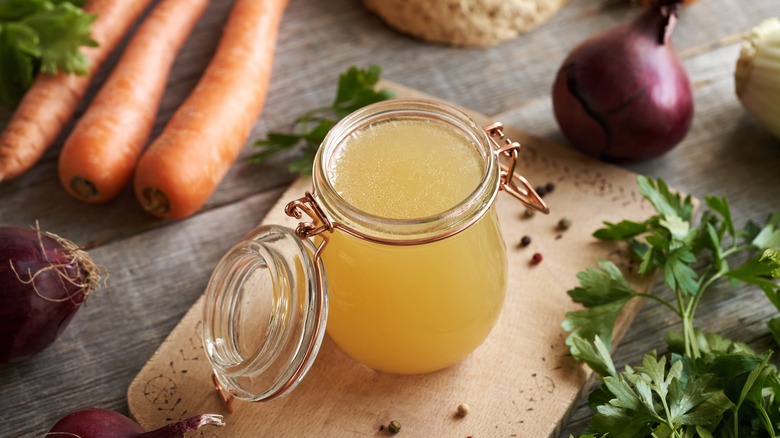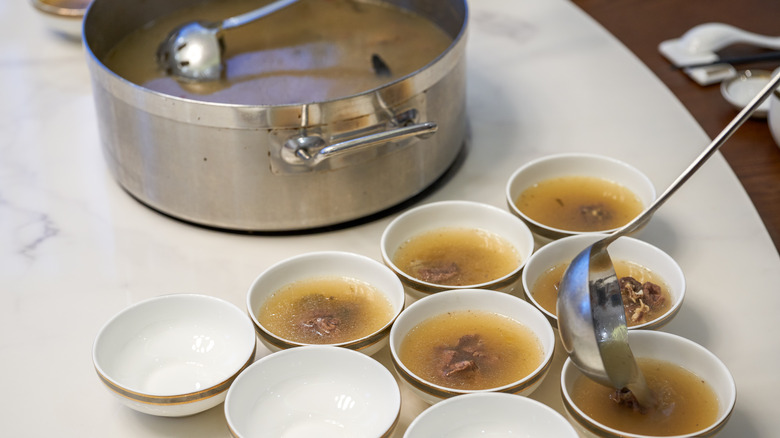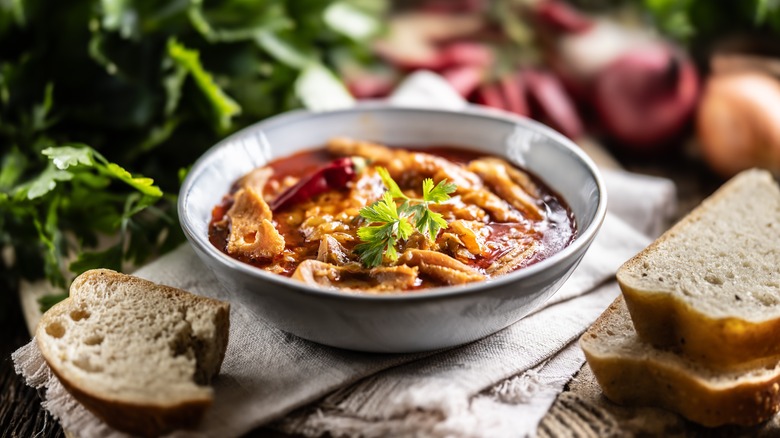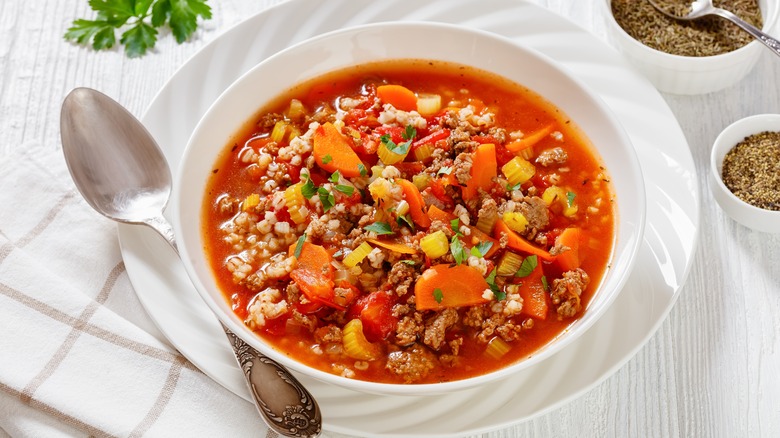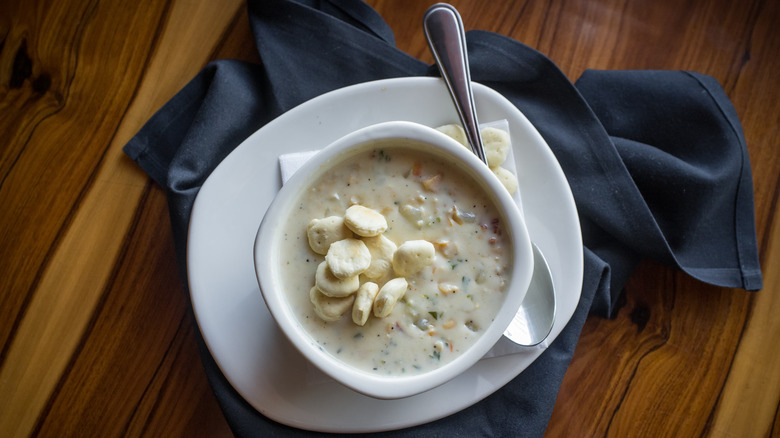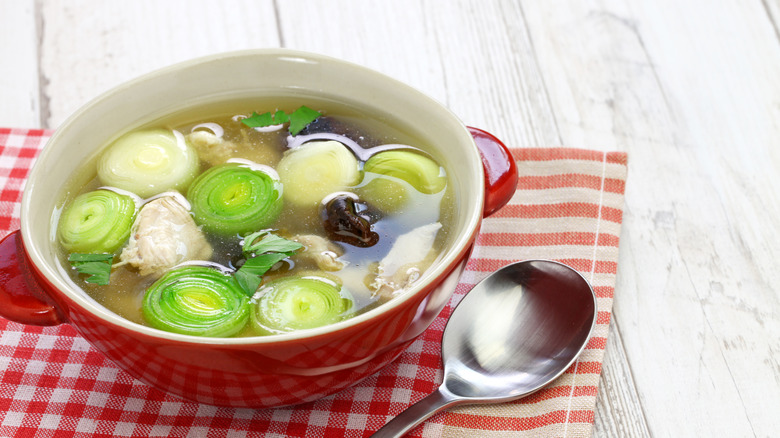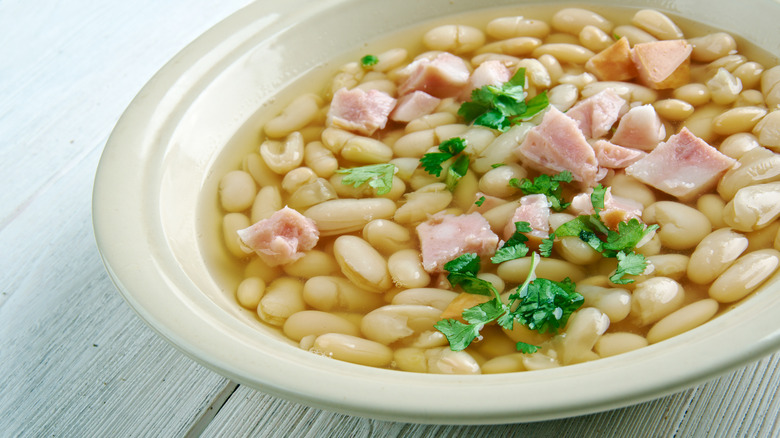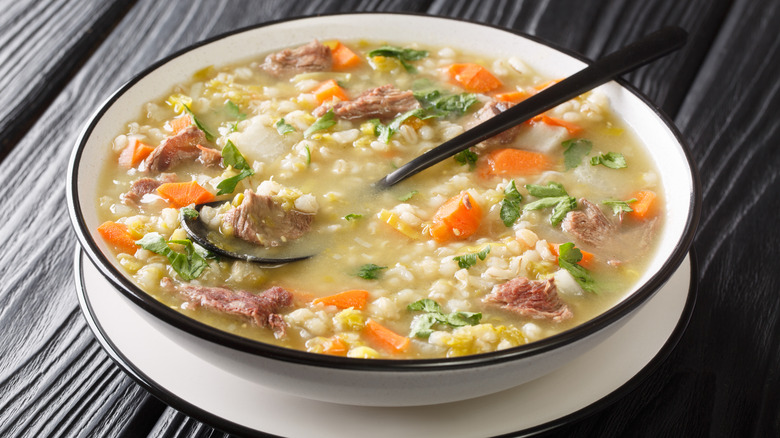13 Old-School Soups You'll Rarely Find At Restaurants Today
Whether you're feeling under the weather or tucking into a multi-course feast, nothing hits the spot like a great bowl of soup (no matter the season). The versatile dish, served hot or cold, is beloved across cultures and central to many cuisines. It's known as the ultimate comfort food, and is also great for feeding a crowd, with highly adaptable recipes inherently easy to add to and multiply. Moreover, the flavor of soup often improves over time spent simmering. For these and other reasons, soup has long been a favorite cooking hack among savvy home chefs and professionals alike. It might even be one of the world's oldest prepared foods, served in the earliest restaurants across Europe and Asia.
Despite the ancient origins of soup, it's as susceptible to evolving tastes and trends as anything else. The soups on contemporary menus are likely different from, say, the ones served centuries ago in Paris. While classic varieties of chicken noodle soup or creamy tomato soup might never go out of style, these 13 old-school soups are rarely found at restaurants today.
1. Consommé
Known for its silky, crystal-clear consistency, consommé is more than meets the eye. It's a concentrated stock made of protein (nearly any type will do) that's been clarified to produce a flavor bomb high in gelatin and rich in salty, savory goodness. In its heyday, consommé was considered an important example of French cuisine. At once delicate and luxurious, it was often served as an appetizer in fancy restaurants. It can be eaten on its own, or used to poach other ingredients like meat or vegetables — if you can find some, that is. That's become much harder to do.
If you're thinking that consommé sounds a lot like the bone broth popular today, you wouldn't be wrong. You could even say that the latter has replaced the former in our culinary lexicon. More rustic bone broth has become ubiquitous across the United States, with grocery stores everywhere selling multiple brands of bone broth, and many restaurants offering their own twist on the nutritious trend. However, despite what we know about the health benefits of bone broth, more elegant consommé has seemingly fallen out of fashion.
2. Turtle soup
Depending on what part of the country you're from, it might shock you to learn that Americans used to hunt and eat turtles. The tradition of turtle hunting parties, or "turtle frolics," dates back to the 18th century, when the festivities culminated in a giant pot of turtle soup. Turtle meat was a common protein for Native Americans and, rumor has it, the Founding Fathers celebrated the signing of the Declaration of Independence with a hot bowl of turtle soup.
In "Appetite City: A Culinary History of New York," historian William Grimes describes turtle soup as a rich and viscous combination of turtle meat, root vegetables, and seasonings like Worcestershire sauce, lemon juice, and sherry. The broth itself was made from the turtle's organs, ensuring that the entire animal was used. For a more-budget friendly alternative, home chefs would often substitute pork or veal.
Turtle soup was on restaurant menus for many years until, due to overfishing, multiple species became endangered. If you're interested in tasting turtle soup, whether out of nostalgia or curiosity, we've got bad news and good news. The bad news is, it's pretty hard to find these days. The good news is, a plant-based food development company has created an AI-generated recipe for turtle soup, hold the turtle.
3. Vichyssoise
If prompted to picture a cold soup, you'd probably think of gazpacho. About 100 years ago, it could have just as easily been vichyssoise.
The chilled, creamy combination of potatoes and leeks was first created in the early 1900s by Louis Diat, a young chef de cuisine at the brand-new Ritz-Carlton hotel in New York. Diat modeled the recipe after his French mother's cooking and named it for his hometown near the resort of Vichy. Diat intended for his refreshing vichyssoise to be served during the summer, but diners loved it so much, it became a permanent fixture of the menu — at the Ritz-Carlton in New York, but also around the country.
The original grew to be so popular that other renditions of vichyssoise popped up, including a condensed version by Bon Vivant Soup Company, then a major rival of Campbell's. One fateful evening in 1971, a couple purchased a can to eat for dinner. Hours after tasting (but not finishing) the soup, the husband was dead and the wife left permanently paralyzed from botulism poisoning. The sad story made the national news, turning American diners off the chilled soup. Bon Vivant was forced to close, and vichyssoise's reputation never fully recovered. You'd be hard pressed to find it on a menu today, but there are plenty of recipes to try at home, like this Vichyssoise de Courgettes (made with zucchini) and Asparagus and Leek Vichyssoise.
4. Fruit soup
While the United States has not yet given Scandinavian food the same attention as other cuisines, waves of popularity have brought some classic dishes to the forefront. They include things like dense rye bread, smoked fish, and the muesli that's often served with yogurt as part of a full Swedish breakfast. They do not include traditional Scandinavian fruit soup, or fruktsoppa, but perhaps they should.
An ancient dish still common around Sweden, Denmark and Norway, fruit soup can be made with any combination of dried fruits, like prunes, apricots, and raisins. Tapioca pearls are used as a thick and hearty base, and sometimes cream is added for a satisfying, sweet soup that can be enjoyed hot or cold.
For a time, fruit soup was a staple in Scandinavian-American households, especially in the Midwest, and especially around the holidays. It's now essentially considered forgotten stateside, but as Americans take renewed interest in Nordic cuisine, here's hoping that fruit soup finally makes its way into the culinary spotlight.
5. Pepper pot soup
In December, 1777, the Continental army was cold and struggling, so General George Washington asked Army baker general Christopher Ludwick to prepare something special to lift their spirits. Ludwick's solution was pepper pot soup, a hot and spicy mix of meat, vegetables, and peppercorns that may have been inspired by Caribbean cuisine. The soup nourished the American soldiers, the soldiers won the Revolutionary War, and pepper pot's place in history was sealed. In fact, to this day, December 29th is National Pepper Pot Day.
Pepper pot soup quickly became a popular comfort food, and perhaps one of America's original street foods, sold in markets by Colonial Black women. It was known as much for its patriotic roots as for its distinct flavor. The not-so-secret ingredient is tripe, which Campbell's combined with potatoes, onions, carrots, jalapeño peppers, and red pepper flakes when it launched a canned version in 1899. For more than 100 years, the soup was sold by major grocers. However, in 2010, the company discontinued it, citing poor sales. It's also no longer served widely in restaurants, so those wanting to try this nostalgic soup will likely have to make their own.
6. Rivel soup
Brought to us by Pennsylvania Dutch and Amish Mennonite communities, rivel soup is often compared to chicken and dumplings, or chicken noodle soup, or spätzle. It could rightly be described as a combination of all three, made by dropping tiny pinches of dough (a simple combination of flour, egg, and salt) into boiling broth flavored with meat (typically chicken) and vegetables. These are the rivels.
Like many homestyle dishes, rivel soup has many variations. Recipes are passed down for generations, and each household has their own preferred methods and ingredients. Common additions include corn, onions, potatoes, and cream. Sometimes, the chicken is swapped for a different type of meat, or no meat at all. The only non-negotiable in rivel soup is the rivels themselves, which serve to add texture and heft to an otherwise light meal.
Given the flexibility and frugality of the humble ingredients, it's easy to see why rivel soup was historically loved by working-class families. It's not so easy to see why restaurants haven't followed suit, considering how comforting and delicious a bowl of rustic, old-school rivel soup can be.
7. Hamburger soup
Don't let the name fool you. Hamburger soup, a favorite of Ronald Reagan's, doesn't taste like your favorite burger recipe. There's nary (thankfully) a slice of pickle or cookout condiment in sight. Instead, the recipe for hamburger soup published by the Reagan Library calls for a warming, savory blend of ground beef, tomatoes, hominy, and chopped vegetables like green bell peppers, carrots, onion, and celery. Seasoned with bouillon cubes added to beef broth, it's a simple yet satisfying soup that freezes well and is sure to please a crowd.
Since the 40th American president helped put it on the national radar, classic hamburger soup has remained popular across the country. Some home chefs like to substitute hominy for barley, which thickens the broth to make it eat more like a stew. Others recommend adding dried herbs and spices, and even a pinch of red pepper flakes for a little spice. No matter how you like yours, you'll likely agree that hamburger soup has earned its status as a comfort food classic. Why most restaurants today choose not to serve it, then, is a mystery.
8. Borscht
A celebration of the humble beet, classic red borscht is a staple of Russian and Eastern European peasant cuisine. It can be served hot or cold, chunky or smooth, topped with hard-boiled eggs or a dollop of sour cream — but whatever you do, don't knock it till you try it.
Those unfamiliar with borscht or wary of beets in general might be turned off by the soup's vibrant hue, which can range from bright pink to very deep red. The color is made more striking by a splash of white, so the addition of cream is as beautiful as it is tasty. Tangy, savory, herbaceous, and a little sweet, borscht offers a unique combination of flavors. Is it old-school? Yes. Is it delicious? Also yes.
While borscht can be found on restaurant menus in select expat communities, it's largely absent from mainstream dining. This is likely due to the aforementioned color and flavor, both of which can be polarizing. However, it may also be due to the soup's utilitarian origins. There's an old Yiddish saying that calls things "cheap like borscht." Given the rising costs that restaurants face, that could make it a hard sell. Offer the people a good borscht, though, and they'll probably buy it.
9. Stracciatella soup
The word stracciatella translates to "little rags" in Italian and, confoundingly, it has been assigned to three different foods: the semi-liquid interior that makes burrata so sumptuous, a gelato flavor comparable to cookies and cream, and a hearty, homestyle soup whose "little rags" are similar to those in Chinese egg drop soup. In the Italian version, the eggs are whisked with grated Parmigiano Reggiano before being dropped through a sieve or the tines of a fork into boiling chicken broth.
Along with delicate shreds of cheesy egg, stracciatella soup can include leafy greens like spinach or kale, shredded chicken, small pasta like orzo, and semolina flour or breadcrumbs as a thickener. Nutmeg, cayenne pepper, fresh lemon, saffron, or a drizzle of extra-virgin olive oil (or all of the above) will also work to take the flavor up a notch. But what really makes stracciatella soup special is its silky, eggy texture.
Far less common than its Chinese counterpart, and even Greek Avgolemono, old-school stracciatella soup is hard to find in restaurants in the United States. But it's no less delicious, so if you ever find yourself in a position to order it, you really should.
10. Oyster stew
When the first English settlers arrived at Plymouth Rock, they were introduced to the oysters that Indigenous peoples had been eating for a very long time. As populations arrived from other countries, bringing their culinary traditions with them, they learned to adapt their recipes to use what ingredients they could find in their new homeland. Oysters were available in cheap abundance along the East Coast, and thus nostalgic American dishes like oyster stuffing and oyster stew were born. The latter was the invention of Irish immigrants, who used the mollusk in place of dried ling fish. It was a hit, and as oysters were eventually transported to other parts of the United States, a love of oyster stew spread accordingly.
Classic oyster stew features a generous amount of shucked oysters swimming in a creamy broth flavored with dry vermouth, diced veggies, and herbs — along with the oysters' own salty brine. It's typically served with aptly named oyster crackers, which add a nice textural component when poured directly into the soup.
Oyster stew became a staple in restaurants across the East Coast and even the Midwest. It was so popular that Campbell's launched a canned version that was recalled in 2012. Since that event, and since the cost of oysters has risen dramatically, the popularity of oyster stew has dropped. Today, it's much harder to find on a menu, but curious cooks can make their own homestyle oyster stew with canned oysters, if they can't get them fresh.
11. Cock-a-leekie
A storied Scottish soup with Medieval origins, cock-a-leekie is as old-school as it gets. The brothy mix of leeks, chicken, and dried prunes was first served to King James VI in 1598, likely by a chef influenced by French cuisine. For centuries, the soup remained in high regard across parts of Europe, and was even served to first-class passengers aboard the Titanic the day before the ship sank. Such gravitas feels contradictory to the cutesy name, which clearly combines the names of its two main components: a mature chicken, and a lot of leeks.
At the time of cock-a-leekie's invention, leeks were more readily available than onions in Scotland, and fruit like plums were more commonly consumed dried or preserved. It's the addition of those ingredients that set cock-a-leekie apart from other types of chicken soup, giving it a meaty texture and slightly sweet flavor that you simply won't find elsewhere. And speaking of finding, while cock-a-leekie is still served in Scotland, it's a rare sighting stateside, despite the fact that the ingredients are widely available and the flavor widely enjoyed. If any nostalgic soup is due for a comeback in American restaurants, it might just be this one.
12. Senate bean soup
According to the official recipe published by the United States Senate, Senate restaurants must serve a specific bean soup daily. It's a simple combination of navy beans, smoked ham hock, and onion cooked in butter and broth. Since the early 20th century, when the soup was first documented, a few updates have been introduced. For example, it's not unheard of to add chopped garlic and celery, top the broth with fresh parsley, and serve the entire thing ladled over mashed potatoes. That's apparently how one representative from Idaho preferred it, but it's not the original Senate bean soup, and not the one legally required to remain on the menu.
The exact origins of Senate bean soup are unknown, as conflicting stories have it being requested by different Senators, from different states. Nonetheless, it now remains a fixed part of the nation's culinary heritage, at least once you get close to the Senate floor. Away from those hallowed grounds, it's much more difficult to find. While other types of bean soup, like black bean soup and 3-bean chili, remain common, Senate bean soup rarely makes an appearance outside of Washington, D.C. If you're dead set on trying it, you might just need to make your own at home, or run for office.
13. Scotch broth
Offering far more than its moniker implies, Scotch broth is not a thin soup (or "washy stuff," as the Scots of yore would say.) In fact, it's closer in consistency to a stew, packed with barley, root vegetables, and meat. It's typically made with a hearty cut like lamb shank, lamb shoulder, bone-in beef shoulder, or oxtail, making for a rich and rustic flavor that deepens over time.
Scotch broth was made in big batches as early as the mid-1700s — and centuries later, Campbell's had canned its own version of lamb, carrots, barley, and potatoes in savory mutton broth for widespread consumption. The product became so well known that, in 1969, Andy Warhol famously immortalized Campbell's Scotch broth in a limited-edition lithograph sold by the Carnegie Museum of Art. However, despite those 15 minutes of pop culture fame, interest in the actual soup eventually waned. Campbell's discontinued its Scotch broth, leaving some fans distraught and begging for the recipe. To this day, the old-school soup is rarely seen on a restaurant menu or elsewhere.

